Respect grows, fondness dwindles,
Is this what is it to grow up?
Understanding behaviors and desires that once seemed so far removed,
More compromises, more sacrifices
It sounds grave, but when you’re living it, it’s beautiful—the growing.
Reading stories to little ones,
Their hands holding my hands,
Their heads tucked under my arm,
Cheeks against my chest,
Their eyelashes fluttering, as they fight the heaviness of sleep.
I’m exhausted, but I’m elated.
The stability, the routine,
Though I don’t have it yet,
I am beginning to see what family will be to me.
An inextricably strong magnetic center,
Pulling all the scattered pieces of my life into place.
Not like a jigsaw puzzle,
Because I know the pieces could never fit so neatly,
But more like a collage.
And that collage coming together doesn’t mean it won’t be unbelievably hard,
Messy, chaotic, aggravating,
But it will be mine.
Saving 1,000 Lives a Day: Why the IANSA’s Humanitarian, Intersectional Approach to Gun Violence Is the Future of the International Community
Gun violence has become a critical global concern for many nations and citizens. While many nations have been successful in curbing incidents of gun violence, it is clear that others are struggling to do the same. From my perspective, this is highly problematic and is something that the international community should be working much more vigilantly to combat. According to the network known as The International Action Network on Small Arms, no less than 1,000 people around the world die from small arms and light weapons everyday. As a young person living in the United States, I have witnessed IANSA’s statistics for myself, with shootings in schools, concert venues, and nightclubs being aired on the news frequently. Many people, especially young people, in North, Central, and South America have the high statistical probability of gun violence hanging over their heads wherever they go.
Personally, I appreciate IANSA as a network because, ever since their founding in 2002, they have been committed to an incredibly personal, ethical, and need-based approach to gun violence. IANSA aims to raise awareness about gun violence and concentrate resources to make them more accessible. IANSA’s website alone has resources from United Nations Conferences, videos, information about relevant campaigns, reports, and briefing papers. They even unite a significant number of NGOs and other political actors, such as Women for Peace and Democracy, Security Research and Innovation Centre, and the Arias Foundation. While more traditional organizations like the Gun Violence Archive can be circumstantially educational, I believe they often minimize the issue of gun violence and its deeply personal impacts by exclusively sharing statistics, whereas organizations like IANSA amplify the humanity behind the issue of gun violence. I have to wonder, what important considerations are we missing when we reduce people’s experiences with gun violence to just another number?
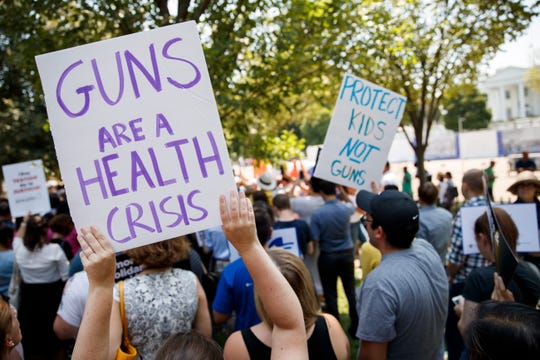 Because gun violence has such a direct impact on the lives of individuals, their families and their communities, IANSA and the organizations highly concerned with issues of human security and human rights. Human rights and security are heavily dependent on the international community. There is also a constant tension between the rights of individual people and the rights of society. For example, some people argue that it should be an individual right for them to bear arms, while others argue that the societal right of protection against gun violence should take priority. In response to this controversy, IANSA shares people’s personal anecdotes and moving pictures and videos to demonstrate the consequences of positioning an individual’s rights over a society’s. The network does this in the hopes of highlighting the lack of ethical and humanitarian considerations realized in placing the individual right to possess guns over the societal right to safety.
Because gun violence has such a direct impact on the lives of individuals, their families and their communities, IANSA and the organizations highly concerned with issues of human security and human rights. Human rights and security are heavily dependent on the international community. There is also a constant tension between the rights of individual people and the rights of society. For example, some people argue that it should be an individual right for them to bear arms, while others argue that the societal right of protection against gun violence should take priority. In response to this controversy, IANSA shares people’s personal anecdotes and moving pictures and videos to demonstrate the consequences of positioning an individual’s rights over a society’s. The network does this in the hopes of highlighting the lack of ethical and humanitarian considerations realized in placing the individual right to possess guns over the societal right to safety.
The intersectionality of this organization is another feature that I believe makes it the most critical international anti-gun violence network. I would argue it is also one of the newest international concerns being addressed by the network considering the term intersectionality was only coined by Kimberlé Crenshaw in the 1980s. In recent years, the issue of gun violence has come to the forefront in light of the instances of police brutality and gang violence that have taken the lives of countless black men, women, and children in the U.S. In fact, the Brookings Institution asserts that more than 11 percent of the total years of potential life lost among the black population in America can be accounted for by firearm deaths. (You can learn more about the relationship between gun violence, gender, poverty, and race in America here.) According to an article published by National Public Radio, Central and South American countries like El Salvador and Venezuela have seen gun violence escalate with increased rates of poverty, gang activity, and drug trafficking. Often, the gun violence spurred by these circumstances results in the death of innocent people who get caught in the crossfire.
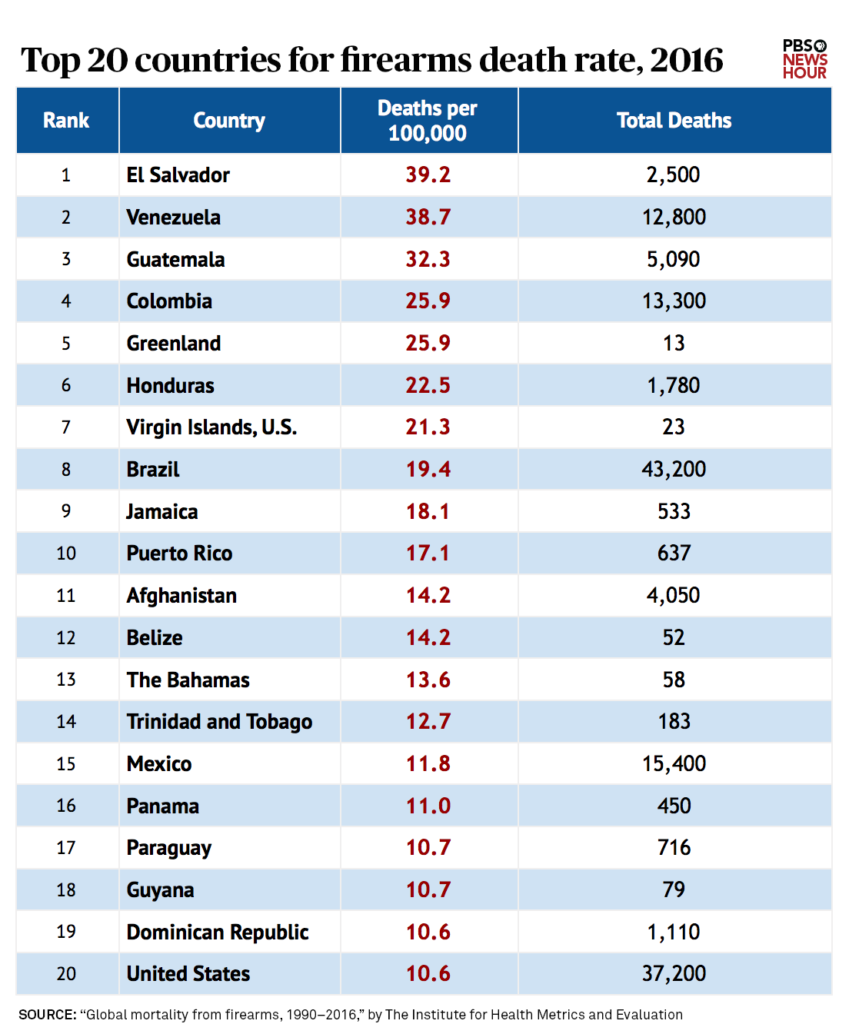
The problem with traditional methods of observing international gun violence (as are modeled by the cart on the right) is that they often only consider the direct outcome–death. But as is evident in the examples from the U.S., El Salvador, and Venezuela, the impacts of gun violence are often compounded by other social circumstances, like gender, race, and poverty. The result is an array of long-term negative outcomes which death statistics fail to measure, such as poor mental health, violent behavior among youth, and increased rates of acquired disability.
“Gun violence can have a series of serious snowball effects in education, health, incarceration, family instability, and social capital . . . Individuals who witness violence are also at increased risk for a variety of mental health issues, which can manifest as post-traumatic stress disorder, depression, poor academic performance, substance abuse, risky sexual behavior, delinquency, and violent behavior”
– David Hemenway, Harvard School of Public Health
These relationships between other social concerns and gun violence comprise another alternative angle that IANSA intentionally acknowledges and addresses. The network interviews people from all around the world, like Alex Galves, who was shot at a convenience store when he was a young man and now lives with a permanent disability. It also publishes briefing papers with titles like “A Call to Action by Civil Society On Gender and Small Arms Control” to educate its members about gendered issues such as firearm intimidation against women and the fundamentally gendered nature of gun ownership.
That being said, while I cannot require that you change your mind about approaches to gun violence, I can ask that you consider the benefit of alternative approaches taken by international networks like IANSA. Gun violence is acknowledged by the international community as a universal problem. Since this is the case, wouldn’t you think there would be greater international political action to combat gun violence? Yet, traditional approaches to combating gun violence have shown little merit and few alternatives have gained adequate traction among political actors. What might the reasons for this be and what are potential solutions to this international political stagnancy? To what extent could a humanitarian, intersectional approach, like the one adopted by IANSA, be part of the solution?
Sources:
Aizenman, Nurith. 2017. “Gun Violence: Comparing The U.S. With Other Countries.” NPR. https://www.npr.org/sections/goatsandsoda/2017/11/06/562323131/gun-violence-comparing-the-u-s-with-other-countries (June 10, 2020).
“George Floyd Protests Live Updates: Demonstrations Resume as Mayors Call for ‘Peace, Not Patience’.” 2020. The New York Times. https://www.nytimes.com/2020/05/31/us/george-floyd-protests-live-updates.html (June 10, 2020).
“International Action Network on Small Arms: IANSA.” iansaresources. https://www.iansa.org/ (June 10, 2020).
“Key Facts about Gun Violence Worldwide.” Amnesty International. https://www.amnesty.org/en/what-we-do/arms-control/gun-violence/ (June 10, 2020).
https://www.nytimes.com/2020/05/31/us/george-floyd-protests-live-updates.html
Reeves, Richard V., and Sarah Holmes. 2016. “Guns and Race: The Different Worlds of Black and White Americans.” Brookings. https://www.brookings.edu/blog/social-mobility-memos/2015/12/15/guns-and-race-the-different-worlds-of-black-and-white-americans/ (June 10, 2020).
“The Human Security Unit – UNITED NATIONS TRUST FUND FOR HUMAN SECURITY.” United Nations. https://www.un.org/humansecurity/ (June 11, 2020).
Image Sources:
First Image via The Cincinnati Enquirer
Second Image via PBS
Now is Not the Time
But now is not the time,
To watch rain drops gather on the window pane.
It is the time to run,
To read,
To dance.
It is the time for as many trivial tasks,
And as many miserable distractions we can invent.
But the lamp still flickers,
And the rain still falls,
To remind us,
(As if we did not have enough reminders)
Time is fleeting.
It has been leaving us, walking away,
Since the day we first arrived on earth.
Though as we grow,
As our knees bare more scars,
From falls on the concrete,
And our hands become covered in calluses,
From years of clutching tightly to the handlebars of our bikes,
Bulbs turn to blossoms,
And we are reminded that time will reward us too.
(Never with more time, of course)
But with the familiar sound of wind chimes that can be heard on a breezy summer afternoon,
The hum of a tune from a cheap electronic keyboard,
A memory of sunlight glittering through a canopy of reds, yellows, and oranges,
Or the warm glow of a storefront window on an evening in December.
Now is not the time,
To think of that which we have lost,
And will never get back,
To invent trivial tasks or miserable distractions.
To fear the passing time,
In which the joy and magnificence of our lives are being unfurled.
And so blossoms turn to leaves,
Leaves fall to snow,
And we are older,
But somehow we are newer too.
Soak Spa Portfolio
This is a series of marketing designs and photographs I created during my time at Soak Spa & Foot Sanctuary, a small, local day spa in Fort Collins, Colorado.
Designs Formatted for the Instagram Stories Feature on Instagram:

















Designs & Images Formatted for Instagram & Pinterest:











Designs Formatted for Commercial Signage:



What’s the Deal with Vouchers?
I just finished reading an article about what’s ahead for private school choice in 2019. The article discusses voucher programs as well as alternative programs that are being proposed in private school choice policy. It discusses areas of contention and the difficult questions being brought up as support for voucher programs grows.
“For years, there has been this existential battle,” he said. “Should school choice [programs] be for low-income students or for all students?”
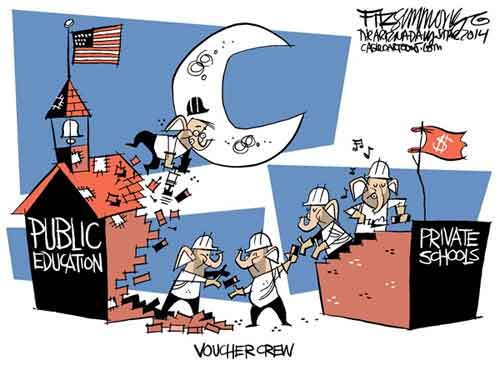 Though the concept of school vouchers is not new, it has been especially prominent on recent ballots and has proven incredibly controversial amongst voters. Those who argue against the implementation of vouchers see problems with he concepts of “school competition,” are concerned with the quality of education in voucher schools, and worry about its accessibility for disadvantaged students. Much of the resistance to vouchers has come from professional educators, because vouchers stress greater involvement in decision-making from students’ guardians and community. This has left educators wondering where their voices fit into education vouchers, or if they fit in at all. Many parents, teachers, and administrators involved with alternative schools which have been founded on a specific educational need are concerned about the random selection method having a negative impact on their schools’ climates and the quality of education for individual students. Another grave concern of those who oppose vouchers is their allowance of a direct violation of the separation between church and state under the circumstance that private schools are being subsidized by religious entities. Moreover, private school vouchers take students away from public schools, which creates funding/resource deficiencies in already struggling institutions and greater disparities in the quality of education students are receiving.
Though the concept of school vouchers is not new, it has been especially prominent on recent ballots and has proven incredibly controversial amongst voters. Those who argue against the implementation of vouchers see problems with he concepts of “school competition,” are concerned with the quality of education in voucher schools, and worry about its accessibility for disadvantaged students. Much of the resistance to vouchers has come from professional educators, because vouchers stress greater involvement in decision-making from students’ guardians and community. This has left educators wondering where their voices fit into education vouchers, or if they fit in at all. Many parents, teachers, and administrators involved with alternative schools which have been founded on a specific educational need are concerned about the random selection method having a negative impact on their schools’ climates and the quality of education for individual students. Another grave concern of those who oppose vouchers is their allowance of a direct violation of the separation between church and state under the circumstance that private schools are being subsidized by religious entities. Moreover, private school vouchers take students away from public schools, which creates funding/resource deficiencies in already struggling institutions and greater disparities in the quality of education students are receiving.
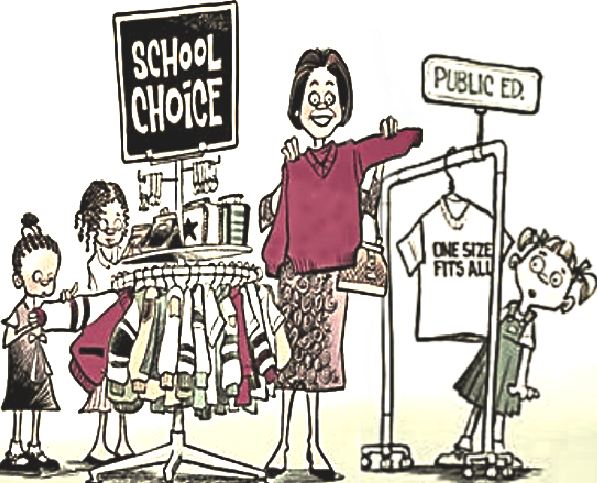 On the other hand, those who argue for school vouchers insist it greatly improves school choice, channels special resources for the disadvantaged, and gives principals and teachers increased freedom to vary their teaching methods. The voucher gives parents the opportunity to give their child a quality education and to have more control over what that education looks like. If the proper systems and protocol are put in place, the voucher program can be a great way for disadvantaged students to be given increased access to a quality education their neighborhood district may not be capable of delivering. This program does require strong financial backing, but if the funds are successfully supplied, it has the potential to be effective in revolutionizing school choice. Moreover, if school competition plays out the way vouchers intend for it to, an overall higher standard of education could be met.
On the other hand, those who argue for school vouchers insist it greatly improves school choice, channels special resources for the disadvantaged, and gives principals and teachers increased freedom to vary their teaching methods. The voucher gives parents the opportunity to give their child a quality education and to have more control over what that education looks like. If the proper systems and protocol are put in place, the voucher program can be a great way for disadvantaged students to be given increased access to a quality education their neighborhood district may not be capable of delivering. This program does require strong financial backing, but if the funds are successfully supplied, it has the potential to be effective in revolutionizing school choice. Moreover, if school competition plays out the way vouchers intend for it to, an overall higher standard of education could be met.
From my perspective, school vouchers seem to be incredibly conditional. They have the potential to be beneficial, but only with adequate funding, clear regulations, proper administrative protocol, majority voter support, and gradual implementation. It seems there are a multitude of elements that would have to come together in a specific way so vouchers do not result in greater disparities in educational quality, discriminatory practices against disadvantaged students, and violations of the separation between church and state. I am absolutely convinced vouchers will have almost exclusively negative impacts on public education. As an aspiring public school teacher, I am obviously inclined to consider the gravity of this impact and to, from that perspective, oppose vouchers. However, I think it is also important to remember that public education is not the only form of education. 10 percent of all students attending school in the U.S. attend private schools. While this is a minority, and the percentage has been higher in the past, there is no way to say for sure that this percentage could not grow exponentially in the coming years. From this perspective of having absolutely no way of telling what the future holds in regards to education, I think vouchers warrant consideration. They may not be the best option for education now, but nothing is certain, and they absolutely could be at some point down the road, so we may as well begin working to develop and refine them to be as effective as possible right now.
List of Educational Issues
- Common Core – potential to develop complete and challenging education for all students? Equal access/opportunity?
- Grade repeating/being “held back” – Does it help or harm student success?
- Homework – does it assist student learning/understanding?
- Traditional grades – should students be given letter grades? Benefits? Problems? What is the replacement?
- Vouchers – Scholarships for Kids Act by Sen. Alexander would repeal a large number of ESEA programs and give states the option of using their ESEA Title I, Part A allocation for a “Scholarships for Kids” program that includes public and private schools (http://www.nea.org/home/16378.htm).
- Achievement gaps
- Privatization – Threat to public ed.? Threat to democracy? For-profit corporations being responsible for education–how does that look? What does that mean for students, parents, teachers, etc.?
- Rural Schools – disadvantaged by size and geography, under-funded, lack steady revenue, rural educators fulfilling many duties outside of their job description to compensate for lacking external support
- College affordability and debt services
- Education Funding
- Dropout prevention – grad. rate of minority groups, students with disabilities, and students living in poverty all fall below national average; middle grades interventions, invest in prof. development, advocate for students support
- School-to-prison pipeline – Seventy percent of those arrested or referred to the police at school are Black and Latino. Average spending to incarcerate – $88,000, Average spending to educate – $10,000 (http://www.nea.org/home/DropoutPrevention.html).
- School safety – school shootings, response to crisis, training, preparedness, preventing school violence
- Standardized testing – Does testing take time from learning? Increased flexibility, locally developed assessments rather than statewide
- Immigration – broken system, fear, distress; call for reform; REALISTIC PATH TO CITIZENSHIP
- ELL – achievement gaps, research advocacy, comprehension, specific teaching strategies, technical assistance, involvement of and communication with the family; how can we eliminate this disparity?
The Leadership Compass Self-Assessment
I scored highest in the “Analytical” style of leadership and second highest in the “Vision” style. Because I am analytical, I will be able to make well thought out decisions that take as many factors into account as possible. I will be able to think methodically and produce consistent outcomes. I am good at understanding situations and individuals from a practical perspective, and when a problem arises I can immediately come up with a list of viable solutions.
While these are the strengths of being an analytical leader, the weaknesses are important to note as well. Being an analytical leader means that I try my best to be objective in situations of conflict, however, this can give the involved parties the impression that I am disregarding or don’t value their individual feelings. Moreover, I have to be careful about my tendency to want to solve problems as soon as possible, because sometimes, people are looking for someone to listen rather than someone to problem-solve.
Challenges that accompany this leadership style might be that I struggle to empathize with people, because I am always thinking about situations and outcomes practically rather than emotionally or intuitively. A challenge I have already encountered frequently, especially with those who fall into the empathy style of leadership, is that I am highly critical of the prioritization of what is “right” and “fair,” because from a practical perspective, it is impossible for things to always be that way. This results in my labeling of these types of leaders as ineffective or overly-emotional, even though their approach is simply different than mine.
This rolls into my areas for growth, because I think this is something I really need to work on. Each leadership style is equally legitimate and important, because it creates an environment of diverse thought and more all-encompassing perspective on any issue. Another major area for growth is working on listening and asking people questions about what they would like from you before supplying them with unsolicited advice, opinions, and information they do not want.
Research Journal One: Introduction to Magical Realism
Previously, I have read Harry Potter, A Midsummer Night’s Dream, One Hundred Years of Solitude, and Midnight’s Children. These are some of my favorite examples of magical realism in the form of plays and novels, but prior to choosing magical realism as the genre for my Unfamiliar Genre Project, I was not aware of how many magical realism short stories are also available in online archives. While exploring all of these, I came across The Daughters of the Moon by Italo Calvino, If A Book Is Locked by Helen Oyeyemi The Seraph and the Zambesi by Muriel Spark, and The Faery Handbag by Kelly Link.
In The Daughters of the Moon, Italo Calvino sets the scene in a Manhattan very similar to present day Manhattan, where the skyscrapers shine, jumbo screens flash new sales, and everyone is always rushing around to buy the newest products. Here, everything is new and nothing is old, except for the moon, which hangs over New York City in its ugly, dusty, dull, battered, state, reminding everyone that everything will inevitably become old with time.
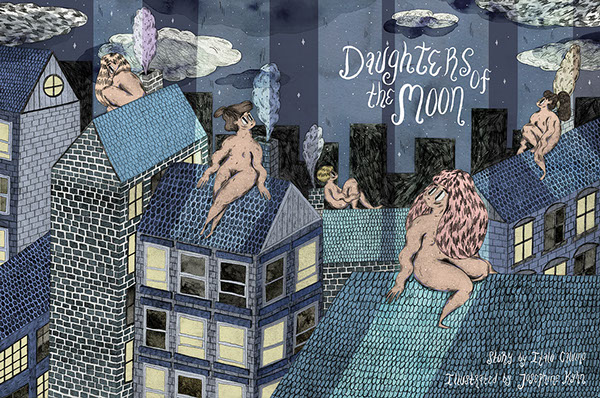
The narrator is driving past Central Park on a night like any other when he spots a girl sitting on a bench, entirely nude. He experiences this inexplicable feeling he knows her, parks his car, and approaches her. He ends up being urged by the woman to drive to a junkyard at the edge of the city with her, still entirely nude, sitting on the trunk of his car. There, they meet countless other lunar women and find a crane, which authorities have built to pluck the ugly, old moon from the sky so it can no longer spoil the shiny, flawless appearance of the city. The crane yanks the moon out of the sky, disfiguring it.
The lunar women tie up the contorted moon and begin to run with it trailing behind them. When they do this, all of the discarded junk begins to follow the moon like waves of men marching in a parade.
And, behind the parade, shop windows became covered with cobwebs and mold, skyscrapers’ elevators started to creak and groan, advertising posters turned yellow, the egg holders in refrigerators filled with chicks, as if they were incubators, televisions reported whirling atmospheric storms. The city had consumed itself at a stroke: it was a disposable city that now followed the moon on its last voyage.
-Italo Calvino, The Daughters of the Moon
The moon then rises, taking the women with it, back to its rightful place in the sky. Following this procession, nature reclaims the earth, civilization ends, and life begins again.
Of the short stories I listed, this one ended up being my favorite, because the characters are interesting and the story draws attention to societal and cultural attitudes that could be perceived as problematic, such as the mass consumerism encouraged by capitalism and the western world’s lacking connection with/appreciation for nature. I feel like Calvino did an incredible job of incorporating all of the elements of magical realism. He incorporated magical aspects by personifying the moon and the automobile junk, realistic elements through his inclusion of Manhattan, Madison Square Garden, and Central Park as major settings, and used the plot to make his audience contemplate the real-world incidents of consumerist and anthropocentrist attitudes.
My hope is to emulate Calvino’s balance and inclusion of elements in my short story. I intend to adapt a realistic setting and some realistic characters while including some magical characters and events in the plot of my story. I love the idea of personifying objects, as Calvino personified the moon and the junk, so I may try to find a way to incorporate this as well. Something I intend to do differently is related to the form of my short story. Because Calvino’s short story was originally published in The New Yorker, I feel like his story is somewhat catered to the typical form of a newspaper. I may include lengthier paragraphs or split up my story into several parts, but regardless, I want it to be a bit more fluid.
Unfamiliar Genre Project: Proposal
“I began to wonder whether anything truly existed, whether reality wasn’t an unformed and gelatinous substance only half-captured by the senses. There was no proof that everyone perceived it in the same way; maybe Zulema, Riad Halabi, and the others had a different impression of things; maybe they did not see the same colors or hear the same sounds as I did. If that were true, each of us was living in absolute isolation. . . . At times I felt that the universe fabricated from the power of the imagination had strong and more lasting contours than the blurred realm of the flesh-and-blood creatures living around me.”
–Isabel Allende, Eva Luna
I would like to pursue the genre of magical realism short stories for my Unfamiliar Genre Project. I want to pursue this genre, because I have thoroughly enjoyed reading magical realism books, plays, and short stories in the past, but have never had the opportunity to write in this genre myself. Moreover,
The closest I have ever come to writing in this genre was in the creative writing class I took in 2015. In this course, we wrote several science fiction and fantasy pieces, some of which ended up bordering on magical realism, though I did not have the knowledge base to realize it at the time.
Magical realism is described as writing which is set in an existing or previously existing place. It includes realistic elements (like the setting and some or all of the characters) while simultaneously including elements that would be unlikely or impossible without external supernatural or mystical force. For example, William Shakespeare‘s A Midsummer Night’s Dream falls into the category of magical realism, because it is set in Athens, Greece, but includes characters like Oberon, king of the fairies, that inflict some sort of magic on the other characters which would not be otherwise possible. This being said, the key elements of magical realism include: ordinary settings, ordinary characters, fantastical elements (plot, time, tone, and atmosphere), and authorial reticence. Some other examples of popular literature that fall into the magical realism genre are: One Hundred Years of Solitude by Gabriel García Márquez, The Night Circus by Erin Morgenstern, Like Water for Chocolate by Laura Esquivel, and Midnight’s Children by Salman Rushdie.
I am anxious to learn about and read texts that fall into this category, because I have had relatively limited exposure to the genre prior to this project. I am curious to see what ideas other authors have come up with and to become more familiar with the elements and structure of the genre. By studying this genre, I hope I can learn to be more creative and flexible in my writing. I have always been able to adequately adhere to very structured, formulaic types of writing, like essays and research papers, but I am hoping this project will assist me in expanding my skills beyond academic writing. My hope is that completing this project will allow me to prove to myself that I am capable of writing creatively, because this is a significant insecurity I wrestle with as a writer.
Images Series: Alcatraz Island


















